
|
|
Grameen bank
|
If you take a flower
You have to give
A
heart like flower.
Give flowers in return
They give
false flowers.
.....................
How will you
carry such a flower?
A flower cannot carry another
flower.
Jasim
Uddin
|
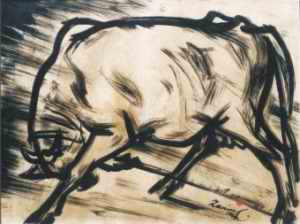 |
1. INTRODUCTION
2. Conventional bank do not lend to the
poor
3. Credit for the ultra-poor
4. Extension and Interaction with Officials
5. Improvements in Well-Being
6. Household Decision-Making
7. Samman/Dignity
8. The Market
9. Savings
10. Village phone programme
11. Pension fund and other savings
12. Self-reliance for GB
13. High Cost of Microcredit
14. The Struggle for Survival and Credibility among the
Religious NGOs (Non-Governmental
Organizations) in Bangladesh
15. CONCLUSION
16. REFERENCES
Grameen's Success - Rabinranath Tagore knew 100 years
ago
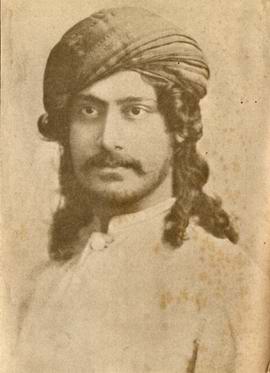 The success of Grameen project
is entirely due to the responsiblity and participatation by
the women. Rabinranath Tagore knew this. The success of Grameen project
is entirely due to the responsiblity and participatation by
the women. Rabinranath Tagore knew this.
In traditional rural society women's place considered to be
high and respectful., as woman is made mother by Nature.
Rabinranath Tagore, the Noble Prize laureate, wrote on 18th
August 1893, Potisar (Padma, downstream of the Ganges),
also Rabinranath Tagore named the boat "Padma",
Bangladesh:
For some time I have been remarking that man
is angular and incoherent, women rounded and
complete. Woman's way of speaking, dressing, moving and
behaving is an integral harmony with her duties in life. And
the main reason is that for ages Nature has defined these
duties and modified these duties and moulded her feelings to
fit to them. . In all her being and doing she unites grace
and skill, her nature and her work, like a flower and its
scent. She acts without conflict or hesitation."
Man's character, by contrast, is uneven, formed by
the various occupations and influences that have left their
mark upon him both inwardly and ouwardly.
......
Woman was made mother by Nature and cast in
that mould. but man has no such primal design, no star
perpetually to gude him
(Rabinranath
Tagore, Glimpses of Bangal, His letters to his niece Indira
Devi)
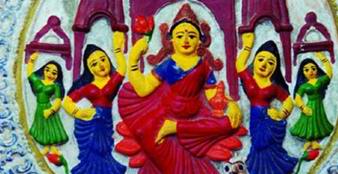 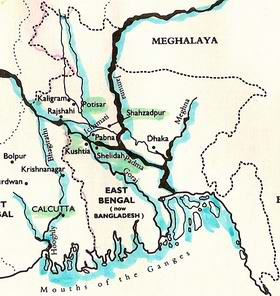
|
Rabindranath Tagore – The Poet And The Man An Analytical
Perspective
Glimpses of Bengal
1. INTRODUCTION
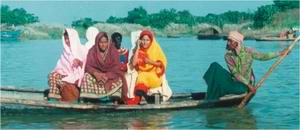 In Bangladesh, the unintended
consequences of the microcredit system with NGOs as partners have
been far-reaching. The very structure of social production that
focused on 'man as the breadwinner' has changed to accommodate a
substantial and permanent role for women as income-earners. In Bangladesh, the unintended
consequences of the microcredit system with NGOs as partners have
been far-reaching. The very structure of social production that
focused on 'man as the breadwinner' has changed to accommodate a
substantial and permanent role for women as income-earners.
'The Grameen Bank' project, an invention of a simple method by a
man from the world's poorest country has become a model for so many
developed and developing countries of Asia, Europe, America and
Africa for changing the fate of their underprivileged people. First
Tagore, then Amartya Sen and finally our very own Dr. Yunus. This is
the type of news that can make a Bangladeshi proud.
The IFAD-government of Bangladesh, Agricultural Development and
Intensification Project (ADIP) covers four districts: Gazipur,
Tangail, Kishoreganj and Narsinghdi. This study of 20 saving and
credit groups (SCGs) formed under the ADIP project in these four
districts of Bangladesh was undertaken to assess the impact of
microcredit institutions on gender relations and women’s agency.
During our fieldwork (from March 17 to 31, 2003), we looked at the
process through which microcredit has enabled the transformation of
a part of women’s domestic labour into an income generating
activity. We looked at the sectors of economic activity in which
this credit is invested and the productive assets acquired by the
members of the SCGs.
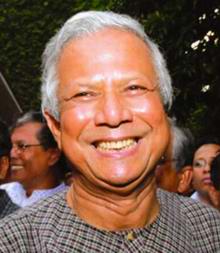 Grameen Bank was initiated in 1976 by
Professor Muhammad Yunus as an action research project of Chittagong
University. In a village near the university called Jobra, he found
that the poor did not have access to small amounts of capital to
engage or build on their tiny livelihood activities. The only source
of capital were loans from money- lenders at exorbitant rates of
interest. As an experiment, he began a project to provide small
loans to poor women in Jobra to engage in income generating
activities. In all cases, the poor women took loans from the
project, invested their money, and generated enough income to pay
back their loans and keep a profit. Grameen Bank was initiated in 1976 by
Professor Muhammad Yunus as an action research project of Chittagong
University. In a village near the university called Jobra, he found
that the poor did not have access to small amounts of capital to
engage or build on their tiny livelihood activities. The only source
of capital were loans from money- lenders at exorbitant rates of
interest. As an experiment, he began a project to provide small
loans to poor women in Jobra to engage in income generating
activities. In all cases, the poor women took loans from the
project, invested their money, and generated enough income to pay
back their loans and keep a profit.
The word "microcredit" did not exist before the seventies. Now it
has become a buzz-word among the development practitioners. In the
process, the word has been imputed to mean everything to everybody.
No one now gets shocked if somebody uses the term "microcredit" to
mean agricultural credit, or rural credit, or cooperative credit, or
consumer credit, credit from the savings and loan associations, or
from credit unions, or from money lenders. When someone claims
microcredit has a thousand year history, or a hundred year history,
nobody finds it as an exciting piece of historical information.
 The Grameen Bank operates on the premise that
the poor remain poor, not because they do not work or do not have
skills, but because the institutions created around them keep them
poor. Charity is not a solution to poverty, but rather fosters
dependency, thus perpetuating poverty. All human beings are born
with unlimited potential, and merely require an opportunity to
unleash that potential. Professor Yunus argues that credit provides
that opportunity and should therefore be considered a human
right. The Grameen Bank operates on the premise that
the poor remain poor, not because they do not work or do not have
skills, but because the institutions created around them keep them
poor. Charity is not a solution to poverty, but rather fosters
dependency, thus perpetuating poverty. All human beings are born
with unlimited potential, and merely require an opportunity to
unleash that potential. Professor Yunus argues that credit provides
that opportunity and should therefore be considered a human
right.
The success of this approach shows that a number of objections to
lending to the poor can be overcome if careful supervision and
management are provided. ‘For example, it had earlier been thought
that the poor would not be able to find remunerative occupations. In
fact, Grameen borrowers have successfully done so. It was thought
that the poor would not be able to repay. But in reality, the
repayment rates reached were 97 per cent. It was thought that poor
rural women in particular were not bankable. The numbers say
otherwise, they account for 97 per cent of borrowers today. Indeed,
from fewer than 15,000 borrowers in 1980, the membership had grown
to nearly 100,000 by mid-1984. Group savings have reached 7,853
million taka, out of which 7,300 million taka are saved by women.
Many people mistakenly consider Yunus as the pioneer of micro-credit in Bangladesh. When Rabindranah Tagore established a bank for the peasants at Potisor in Pabna, he did not coined the term micro-credit. The poet-turned-philanthropist made a huge amount of grant to help poor farmers. He failed to recover the loan, not even 20 per cent. We know about Kabuliwala (Afgani)was who generously gave collateral-free loan to anybody. NGOs later institutionalised it. BRAC was the first NGO that advanced collateral-free micro-credit in its Sulla Project on an experimental basis in 1974 as a package for post-flood rehabilitation. It has become a regular programme of BRAC since 1976 with 12 per cent rate of interest per year.
The government in 1983 established the Grameen Bank (GB) as a non-profit organisation to implement a group-based credit programme for productive self-employment, though it started as an action-research project in 1976. However, it was Yunus who preached credit as a right of the poor. He considers credit as a human right. His hypothesis has been: the poor are bankable.
|
Myth of recovery
The micro-credit programme provides easy access to credit for the poor, as it is collateral free. It also extends awareness service, development education and training on various social and vocational aspects to the beneficiaries for effective utilisation of the credit. Efforts are made to make the poor creditworthy. In spite of these efforts, many borrowers default and ultimately drop out.
When the default rate is very high and the repayment rate declines to an alarming level, it threatens the survival of the institution. Performance of some NGOs has been poor and some of them had to abandon the programme. For some NGOs, the default rate was more than 90 per cent. Low repayment rate has its demonstration effect on others, which often spreads a default culture.
Increased amount of credit is sometimes a problem. A survey conducted by ASA shows that competition of NGOs involved in micro-credit programme in the same area often creates an unhealthy situation and influences in creating default. Organisations like BRAC, Grameen Bank and Proshika provide large amounts of credit to their clients. In an environment of poor infrastructure and hostile attitude of the bureaucracy, the poor people do not have the capability to utilise a large amount through investment as capital. When the loan amount is beyond the capacity, they cannot generate desired income.
GB and some national NGOs have been able to keep their recovery rate high. But there is scepticism about their claim. In the backdrop of low rate of return on labour, high degree of uncertainty and natural disasters, a high rate of repayment to the tune of 99-100 per cent on a regular basis seems to be a miracle. What makes such a high rate possible? The following have been observed in this respect.
Many borrowers have access to multiple sources of credit.
Borrowers are assured of repeat loans. Defaulters’ loan is adjusted with fresh loan and shown as ‘recovered’. Staffs are at a race to show their performance.
Borrowers have multiple sources of income.
Borrowers have to sell assets to clear themselves when in trouble.
Borrowers are intimidated to repay loan.
NGOs incur high staff cost to keep vigilance.
Yunus makes nation proud Shares Nobel Peace Prize with his
Grameen Bank
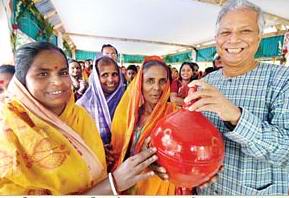 After independence in 1971 and
restoring democracy in ’91, Bangladesh witnessed the biggest
achievement as Professor Muhammad Yunus and his Grameen Bank
were declared yesterday to win the Nobel Peace Prize 2006 for
pioneering the use of micro-credit to benefit poor
entrepreneurs. Prof Yunus is the first Bangladeshi and also
the third Bangalee after poet Rabindranath Tagore and
economist Amartya Sen to win the Nobel Prize. Grameen Bank,
founded by Prof Yunus, has been instrumental by offering loans
to millions of poor Bangladeshis, many of them women, without
any financial security, in improving their standard of living
by starting businesses with the tiny borrowed sums After independence in 1971 and
restoring democracy in ’91, Bangladesh witnessed the biggest
achievement as Professor Muhammad Yunus and his Grameen Bank
were declared yesterday to win the Nobel Peace Prize 2006 for
pioneering the use of micro-credit to benefit poor
entrepreneurs. Prof Yunus is the first Bangladeshi and also
the third Bangalee after poet Rabindranath Tagore and
economist Amartya Sen to win the Nobel Prize. Grameen Bank,
founded by Prof Yunus, has been instrumental by offering loans
to millions of poor Bangladeshis, many of them women, without
any financial security, in improving their standard of living
by starting businesses with the tiny borrowed sums
"Lasting peace cannot be achieved unless large
population groups find ways in which to break out of poverty.
Micro-credit is one such means," said Ole Danbolt Mjøs,
chairman of the Norwegian Nobel Committee. "Muhammad Yunus has
shown himself to be a leader who has managed to translate
visions into practical action for the benefit of millions of
people, not only in Bangladesh, but also in many other
countries." Prof Yunus and Grameen Bank were chosen for the
prestigious award from among 191 candidates, including 168
individuals and 23 organisations.
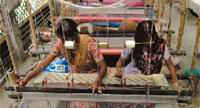 Yunus, dubbed "Banker to the
Poor", began fighting poverty during a 1974 famine in
Bangladesh with a loan of $27 out of his pocket to help 42
women buy weaving tools to save them from the clutches of the
moneylenders. "They got the weaving tools quickly, they
started to weave quickly and they repaid him quickly," said
Mjøs. "Yunus and Grameen Bank have shown that even the poorest
of the poor can work to bring about their own development,"
the Nobel Committee said in its citation. Yunus, dubbed "Banker to the
Poor", began fighting poverty during a 1974 famine in
Bangladesh with a loan of $27 out of his pocket to help 42
women buy weaving tools to save them from the clutches of the
moneylenders. "They got the weaving tools quickly, they
started to weave quickly and they repaid him quickly," said
Mjøs. "Yunus and Grameen Bank have shown that even the poorest
of the poor can work to bring about their own development,"
the Nobel Committee said in its citation.
Today the
bank claims to have 6.6 million borrowers, 97 per cent of them
women, and provides services in more than 70,000 villages in
Bangladesh. Its model of micro-financing has inspired similar
efforts around the world. "Micro-credit has proved to be an
important liberating force in societies where women in
particular have to struggle against repressive social and
economic conditions," the Nobel Committee noted.
Prof
Yunus and the bank will share in the $1.4 million prize as
well as a gold medal and diploma (The Daily Star, October 14,
2006).
Nobel Laureate Professor Muhammad Yunus termed the accolade
a great pride for the country and said it will encourage him
further to dedicate himself for improving the lives of the
poor. Soon after hearing the news of getting the Nobel Peace
Prize, professor Yunus said a world free from poverty is his
dream and he will work to make Bangladesh as a poverty-free
nation.
The entire nation went euphoric as soon as
international media reported on Friday afternoon that
Professor Muhammad Yunus had won this year’s Nobel peace
prize. The proud nation greeted him for his being the
first-ever Bangladeshi to win a Nobel prize as well as for his
accomplishment and that of his famed Grameen Bank. People from
all walks of life—from the head of state to the homeless, from
learners to professionals—greeted the news with joy.
|
Helen Todd spent a year in two villages in Bangladesh following
the lives of women who have been borrowing from the Grameen Bank for
a decade. She focuses on the day-to-day processes of how they
generate money from their tiny loans, what they do with the
resulting income, and how much control they retain over it. In stark
contrast with nonmembers, most Grameen women emerge from this study
as strong individuals, successfully battling for positions of power
in their families and for respect in their villages. Moreover, the
Grameen women's gains have been sustainable, since most of them have
invested in access to land. Through the vivid stories of individual
women, Todd paints a picture of women empowering themselves with the
crucial ingredient of continued access to credit over the course of
a decade (Dhaka Courier, 17 November, 2006).
Back to
Content
2. Conventional bank do not lend to the poor
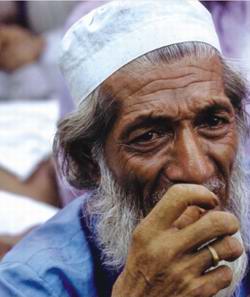 Bangladesh, experts and others say, is less poor than we
think. Yet few are convinced, and nobody tells us who can make us
smile. Once the state could control prices to some degree, but in
this laissez-faire world of non-accountability the free market
becomes an excuse for not keeping misery under control. If nobody
can keep the prices down, of what use is the state, anyway. Might as
well hand the state over to the "syndicate" or an NGO or whoever,
some might say. Bangladesh, experts and others say, is less poor than we
think. Yet few are convinced, and nobody tells us who can make us
smile. Once the state could control prices to some degree, but in
this laissez-faire world of non-accountability the free market
becomes an excuse for not keeping misery under control. If nobody
can keep the prices down, of what use is the state, anyway. Might as
well hand the state over to the "syndicate" or an NGO or whoever,
some might say.
In Bangladesh the poor brown trash are
impossibly hungry. At least 25 percent of the people are half-fed,
often unfed. Between 1972 and 2006, we have been able to manufacture
a new category of wretched people, the extreme poor. These people
own endless mouths which chew on nothing because their jaws find no
food. Economic abstraction makes good fodder for seminars, but it
doesn't make that much sense where the hunger grows. These people
are the colour-coded poor. They carry cards to identify their status
of extreme poverty. These cards, one hopes, will give them access to
the facilities of the state. It's a plea, not a demand. In their
world, rights have limited meaning. The system is built on
occasional morsels of mercy from the state. There is a feeling that
it might be best to keep a distance from the powerful. Nobody is
quite sure about the grammar the state uses to talk to the poor.
"The poor are so poor that we can get nothing from them.
They have nothing to be robbed of. If their lives improve, the
criminals will go after them and that will make our lives insecure.
Should we work to help them?" This is the grammar of a society's
language, where impoverishment has become a protection from
criminals, a collective security blanket of sorts. The poor have
finally become too poor to cause any worry (Afsan Chowdhury,
November 2006).
What actually are the characteristics of these "Poor People"?
Basically they are that part of the society who are relatively most
deprived from income, wealth, education, social security and
political power. They are the defeated victims of an unequal
competition in an intrinsically unequal society. In Bangladesh there
is going on a continuous process of unequal and unjust competition
through which a greater section of the middle class is slowly
becoming the member of a lower middle class and after a brief period
of life and death struggle to hold on they also ultimately in most
cases slide down to swell the ranks of the poor. Now days in the
literature you will find another category: "Poor Becoming Extreme
Poor!"
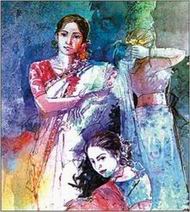 Conventional banks, however, do not
lend to the poor. Banks require collateral and have complicated
procedures that the poor cannot satisfy. The poor are therefore
exploited by money-lenders and traders who operate a system of usury
in villages which is equivalent to bonded labour and slavery. In
another difference with normal banks, ‘Grameen Bank branches are
located in rural areas, whereas the branches of conventional banks
usually locate themselves as close as possible to the business
districts and urban centres. In perhaps the biggest difference, the
first principle of Grameen banking is that clients should not go to
the bank, it is the bank that should go to the people. Conventional banks, however, do not
lend to the poor. Banks require collateral and have complicated
procedures that the poor cannot satisfy. The poor are therefore
exploited by money-lenders and traders who operate a system of usury
in villages which is equivalent to bonded labour and slavery. In
another difference with normal banks, ‘Grameen Bank branches are
located in rural areas, whereas the branches of conventional banks
usually locate themselves as close as possible to the business
districts and urban centres. In perhaps the biggest difference, the
first principle of Grameen banking is that clients should not go to
the bank, it is the bank that should go to the people.
General features of Grameencredit are :
a) It promotes credit as a human right.
b) Its mission is to help the poor families to help themselves
to overcome poverty. It is targeted to the poor, particularly poor
women.
c) Most distinctive feature of Grameencredit is that it is not
based on any collateral, or legally enforceable contracts. It is
based on "trust", not on legal procedures and system.
d) It is offered for creating self-employment for
income-generating activities and housing for the poor, as opposed
to consumption.
e) It was initiated as a challenge to the conventional banking
which rejected the poor by classifying them to be "not
creditworthy". As a result it rejected the basic methodology of
the conventional banking and created its own methodology.
f) It provides service at the door-step of the poor based on
the principle that the people should not go to the bank, bank
should go to the people.
g) In order to obtain loans a borrower must join a group of
borrowers.
h) Loans can be received in a continuous sequence. New loan
becomes available to a borrower if her previous loan is repaid.
i) All loans are to be paid back in instalments (weekly, or
bi-weekly).
j) Simultaneously more than one loan can be received by a
borrower.
k) It comes with both obligatory and voluntary savings
programmes for the borrowers.
A member is considered to have moved out of poverty if her
family fulfills the following criteria:
1. The family lives in a house worth at least Tk. 25,000
(twenty five thousand) or a house with a tin roof, and each member
of the family is able to sleep on bed instead of on the floor.
2. Family members drink pure water of tube-wells, boiled water
or water purified by using alum, arsenic-free, purifying tablets
or pitcher filters.
3. All children in the family over six
years of age are all going to school or finished primary school.
4. Minimum weekly loan installment of the borrower is Tk. 200
or more.
5. Family uses sanitary latrine.
6. Family
members have adequate clothing for every day use, warm clothing
for winter, such as shawls, sweaters, blankets, etc, and
mosquito-nets to protect themselves from mosquitoes.
7. Family
has sources of additional income, such as vegetable garden,
fruit-bearing trees, etc, so that they are able to fall back on
these sources of income when they need additional money.
8.
The borrower maintains an average annual balance of Tk. 5,000 in
her savings accounts.
9. Family experiences no difficulty in
having three square meals a day throughout the year, i. e. no
member of the family goes hungry any time of the year.
10.
Family can take care of the health. If any member of the family
falls ill, family can afford to take all necessary steps to seek
adequate healthcare.
Grameen Bank has been effective because it has been
designed to be supportive of the needs of the poor. Grameen Bank
does not require its members to be literate and its rules are
simple. Each loan is disbursed without collateral with a collection
of principal, interest and savings on a weekly basis, to make
payments easy and manageable. A group mechanism ensures that each
member is part of a system of peer support. Centre meetings take
place at which members gather at their own doorstep to repay their
loans and discuss their projects. The meetings help create an
inter-linking network for the members and ensure an accountable and
transparent system.
|
When the whole country is going on a shopping frenzy (eid
festival), models in flashy designer clothes adorning pages of
different magazines and newspapers trying to coax customers
into buying the latest Hindi-film inspired kameez or sari,
there exist in this city hundreds and thousands of children,
lost and abandoned, who have to struggle day and night to make
ends meet. This is a story of sheer exploitation and utter
indifference; a story where mothers are forced to sell their
newborns for the price of a two-litre mineral water bottle; a
story where children start working as young as five to grow up
stunted and malnourished. |
The sixteen decisions
While providing small loans to the poor is an economic
intervention,
a Grameen Bank loan begins a process of deep transformation in
the lives of its members.
The poor women work hard to bring a host of positive changes in
their lives as their economic condition improves.
The aspirations of the members became incorporated into Grameen
Bank's Sixteen Decisions:
a social charter which the members themselves developed,
encompassing issue such as keeping family size small,
sending children to school, eating green vegetables, drinking
clean water, and
keeping the environment clean.
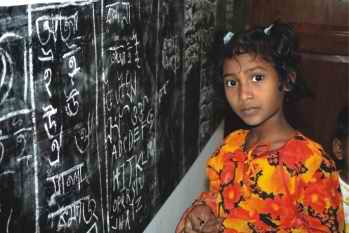 Today, all the children of Grameen
Bank members are in school. Studies show that Grameen Bank members
have lower birth rate than non-members. Their housing is better and
the use of sanitary latrines is higher than non-members. Their
participation in social and political activities is higher than that
of non-members, and reflects how seriously the members implement
these decisions. Today, all the children of Grameen
Bank members are in school. Studies show that Grameen Bank members
have lower birth rate than non-members. Their housing is better and
the use of sanitary latrines is higher than non-members. Their
participation in social and political activities is higher than that
of non-members, and reflects how seriously the members implement
these decisions.
Back to
Content
3. Credit for the ultra-poor
82
percent of the people live on less than $2 a day - Inefficient and
ineffective government and incongruent external influence .
To explode the myth that micro-credit is not useful for the
poorest of the poor, Grameen Bank began in 2004 a programme to give
loans exclusively to beggars. When GB invites beggars to join the
program, it does not discourage them from begging, instead the bank
offers them the option of carrying popular consumer items, financed
by Grameen Bank, when they go out from house to house. They may
choose to beg or sell the items at their convenience. If they find
that their selling activity picks up, they may quit begging and
focus on selling. Till October of this year, 52,000 beggars had
joined the programme. Typical loan to a beggar is about $10, with no
fixed terms of repayment.
Out of 261 women SCG members present in various group
discussions, it was possible to collect accurate information on the
use of loans for 201 women. The percentages in Table 1 add up to
more than 100, since loans are used by individuals for a number of
purposes at the same time. Along with that, numerous sources of
funds are put together for, say buying land or other assets, and
even for investment in various enterprises.
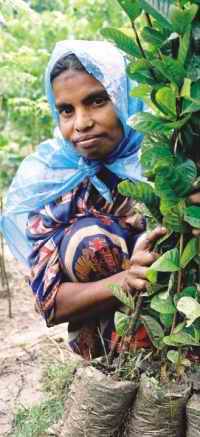
Use of Loan by 201 Women SCG Members
|
Number |
Percentage |
| Agriculture |
77 |
38 |
| Poultry |
54 |
27 |
| Large livestocks |
54 |
27 |
| Grocery shops |
10 |
5 |
| Vegetable selling |
25 |
13 |
| other small business |
14 |
7 |
| Transport/firewood/powerloom |
9 |
4 |
| Homestead |
10 |
5 |
| Housing improvement |
20 |
10 |
| Total respondents |
Total respondents |
|
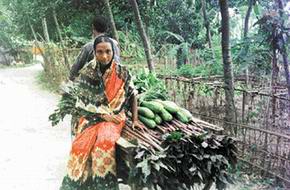 What stands out from Tables 1 is the
predominance of agriculture and related activities in the areas of
livelihood investment – crops, poultry, livestock and vegetables.
Non-agriculture based activities, which include small business, like
tailoring shops, and the clearly men-operated sectors of transport,
firewood and powerloom, all together account for just 15 per cent of
loan uses; adding the 14 per cent in small business, that gives a
total of 29 per cent loans used by men. The possibly more accurate
projectwide figures on main use of loans account for 35 per cent of
loan uses in men’s activities, if we take all non-agriculture
related activities as being men’s activities. What stands out from Tables 1 is the
predominance of agriculture and related activities in the areas of
livelihood investment – crops, poultry, livestock and vegetables.
Non-agriculture based activities, which include small business, like
tailoring shops, and the clearly men-operated sectors of transport,
firewood and powerloom, all together account for just 15 per cent of
loan uses; adding the 14 per cent in small business, that gives a
total of 29 per cent loans used by men. The possibly more accurate
projectwide figures on main use of loans account for 35 per cent of
loan uses in men’s activities, if we take all non-agriculture
related activities as being men’s activities.
Women operate largely in the farm sector, and men much more in
the non-farm sector. Women and men may work together to prepare the
land, but all post-harvest tasks are carried out by women [Chen
1985, Mallorie 2003]. Vegetable production, as also raising poultry
and livestock, have traditionally been women’s activities. Women
report that in general they have better control over the income from
these activities.
There are a few instances of jointly run
enterprises. In one case the poultry business was run jointly by a
woman and her husband. Grocery shops tend to be run by men, but
there are several cases where the shop was close to the house, or in
the village and the women then fully shared the work of running the
shop. There are some outstanding cases of women who, through the
loans have become owners of small businesses and run them as owners
and managers.
Transforming Domestic into Commercial Activity
Where women themselves use the loans, they are invested in a
number of income generating activities – rearing poultry, goats and
cows, homestead vegetable and fruit gardening, pond fish culture,
etc. At one level this is a continuation of activities that women
were already carrying out. The earlier activities, however, were
carried out on a smaller scale, and that too for household
self-consumption. With credit provision there is the new requirement
of repayment, which requires that activities earn cash. This leads
to the transformation of the nature of the activity, even if the
type of labour does not change. Thus, what was in scale a petty and
domestic activity for household self-consumption is upgraded in
scale and changed in nature into a commercial activity for sale.
The critical difference that microcredit to women has made in
patriarchal Bangladesh is that it enabled women themselves to be the
agents of the transformation of a domestic activity for household
consumption into a commercial activity for sale. While the location
or site of this labour may not have changed and remained within the
homestead, the nature of the productive activity changed from being
private production for household-consumption to commercial activity
for sale. Since this transformation was carried out through the
medium of women’s own loans, women thereby remained not just the
labourers, but were also identified as the agents of this
transformation.
Before the microcredit system took root, all of women’s labour
remained within the definition of domestic work, work done for the
care and service of the household. Within this there was no
distinction between so-called productive and domestic/unproductive
tasks. All tasks undertaken by women were uniformly regarded as
being within the realm of domestic labour. But when the product of
this labour became a commodity and the result of it a cash income,
and when this transformation was carried out by credit taken by
women, the very nature of this part of women’s labour in the
household was transformed. It acquired social recognition and,
importantly, women’s own self-recognition as income earners.
We noted several instances of women members who used credit to
buy cows, poultry birds, trees, shops and agricultural lands in
their own names, and not in the name of the husband or son. In one
case nine women and in another case 10 women jointly leased a piece
of agricultural land for vegetable and crop production. They work
jointly on such lands and equally share the produce and cash earned
through sale in the local markets.
“… the family realises that she is the source of this income.
This increases her status and bargaining in the household … Some of
the women in the study perceived a decrease in physical violence
against them around the time of credit group meetings. One women
said that her family was worried that she might retaliate by
refusing to get another loan. n other words, even in being the
conduit for credit, women increase their influence in the household.
This increased influence of women who bring credit into the
household have, is expressed in a number of ways. “Now that I give
him money, he loves me more.” Or, “He listens to me more in deciding
how to spend household money.” Or, “We have been talking to you for
two hours. This would never have happened if we had not given money
to our husbands. They would not have allowed us to sit in a meeting
for this long,” said Maiful, (Mirzapur,Tangail).
How does the micro-credit system work?
A bank branch is set up with a branch manager and a number of
center managers and covers an area of about 15 to 22 villages. The
manager and the workers start by visiting villages to familiarise
themselves with the local milieu in which they will be operating and
identify the prospective clientele, as well as explain the purpose,
the functions, and the mode of operation of the bank to the local
population,’ explains Mohammed Shahjahan, general manager of
commerce, monitoring and evaluation at GB.
Groups of five
prospective borrowers are formed in the first stage and only two of
them are eligible for, and receive a loan. The group is observed for
a month to see if the members are conforming to the rules of the
bank. Only if the first two borrowers begin to repay the principal
plus interest over a period of six weeks, do the other members of
the group become eligible themselves for a loan. ‘Because of these
restrictions, there is substantial group pressure to keep individual
records clear. In this sense, the collective responsibility of the
group serves as the collateral on the loan. The Grameen Bank is
based on the voluntary formation of small groups of five people to
provide mutual, morally binding group guarantees in lieu of the
collateral required by conventional banks.
Loans are small,
but sufficient to finance the micro-enterprises undertaken by
borrowers: rice husking, machine repairing, purchase of rickshaws,
buying of milk cows, goats, cloth, pottery etc. The interest rate on
all loans is 16 per cent. Although mobilisation of savings is also
being pursued alongside the lending activities of the Grameen Bank,
most of the latter’s loanable funds are increasingly obtained on
commercial terms from the central bank, other financial
institutions, the money market, and from bilateral and multilateral
aid organisations.
‘Intensive discipline, supervision, and
servicing characterize the operations of the Grameen Bank, which are
carried out by “Bicycle bankers” in branch units with considerable
delegated authority,’ he adds. The rigorous selection of borrowers
and their projects by these bank workers, the powerful peer pressure
exerted on these individuals by the groups, and the repayment scheme
based on 50 weekly installments, contribute to operational viability
to the rural banking system designed for the poor. Savings have also
been encouraged. Under the scheme, there is provision for 5 percent
of loans to be credited to a group find and Tk 5 (70 Tk= 1 US
Dollar$) is credited every week to the fund.
Back to
Content
4. Extension and Interaction with Officials
Dealing with NGO and project officials is something to be
expected when women become members of the grameen bank. But what is
of interest is to note that other officials, like agricultural
extension officers, also contact these women, which means that they
recognise the role of these women in actually carrying out and
managing certain types of agricultural production. It is no longer
the male “head of the household” who is supposed to be the recipient
of extension messages. The women were proud that they were being
contacted by officials and various technical matters were discussed
with them, and not with their husbands. “Now the block supervisor
comes to meet us, not our husbands,” (Narsinghdi). In Kaliganj,
Gazipur, it was pointed out because of women’s involvement in both
the ownership of land and in field labour, extension officers now
visit and discuss technical issues with the women. This is in sharp
contrast to the experience of the early 1990s, when, for instance,
in IFAD’s Agricultural Diversification Project (MSFDCIP) in
Kurigram, extension effort was confined to men.
Back to
Content
Improvements in Well-Being
|
The fishes find the deep sea,
The birds
the branches of the tree.
The Mother knows her love for
her son
By the sharp pain in her heart alone
Many
diverse the colour of cows,
But white the colour that all
milk shows,
Through all the world, a Mother's name -
A
mother's song is found the same
Jasim Uddin, The
field of the Embroidered Quilt
Translated
by E. M. Milford
|
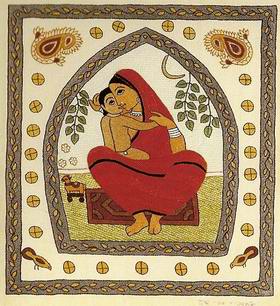 |
|
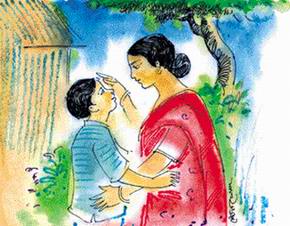 An increase in consumption is to be
expected with an increase in income. Along with a quantity increase
there is also a quality increase in food consumption. Almost
invariably women said that while they earlier had a little vegetable
and not much more with each meal, now they consume more vegetables,
and also eggs and fish once a week each, dal twice a week, and
chicken or beef, once a month, (Bhuapur and Raipura, Narsinghdi). In
another SCG, it was said that they earlier ate fish or meat just
once a month, but now they could afford these once a week. Another
group said that while earlier they ate fish or meat only two or
three times in a month, now their children have milk and eggs almost
daily, (Delduar, Tangail). An increase in consumption is to be
expected with an increase in income. Along with a quantity increase
there is also a quality increase in food consumption. Almost
invariably women said that while they earlier had a little vegetable
and not much more with each meal, now they consume more vegetables,
and also eggs and fish once a week each, dal twice a week, and
chicken or beef, once a month, (Bhuapur and Raipura, Narsinghdi). In
another SCG, it was said that they earlier ate fish or meat just
once a month, but now they could afford these once a week. Another
group said that while earlier they ate fish or meat only two or
three times in a month, now their children have milk and eggs almost
daily, (Delduar, Tangail).
Further, it would seem that in the matter of food, there is no
clear discrimination against the girl-child. Girls get eggs or milk
as frequently as boys do. Overall, as we will discuss later in this
paper, there is clearly a substantial rise in the status of girls,
reflected in the higher enrolment of girls than boys in school.
In the use of income from credit-based enterprises, women
mentioned a greater expenditure for food, clothes, children’s
education, and health, including their own. Women routinely have
more clothes than they had earlier, and more clothes than their
mothers did.
Greater expenditure on health does not in
itself mean better health, but it does show an increased ability to
respond to health problems. Further, with women now recognised as
income earners, there could also be a greater willingness to use
still limited household income for tending to women’s health. The
necessity of making regular, weekly instalments imposes a need to
sustain the income-earning activities from which the payments are
made. This discipline of the market, concretised through the credit
system has been impressed on the routines of household work and
economics, and is also reflected in the rather high usage of
contraceptives in rural Bangladesh.
Improvements in well-being are also reflected in home
improvements. The major home improvements are the substitution of a
tin roof for a thatched one and the addition of some furniture (a
bed, table and chairs), which are now quite common in rural
homes.
Back to
Content
6. Household Decision-Making
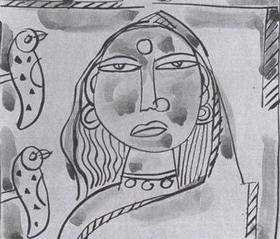 From the fact that a part of household
income now accrues to or through women, one would expect a greater
participation of women in household decision-making. Women generally
report such greater participation. There was more consultation with
women, rather than the earlier unilateral decision-making by men. In
cases where women used credit money to run their own
micro-enterprises, they said that they had more of a say than in
cases where they gave the money to their husbands or sons. From the fact that a part of household
income now accrues to or through women, one would expect a greater
participation of women in household decision-making. Women generally
report such greater participation. There was more consultation with
women, rather than the earlier unilateral decision-making by men. In
cases where women used credit money to run their own
micro-enterprises, they said that they had more of a say than in
cases where they gave the money to their husbands or sons.
Where women themselves carried out the sales, which meant it
was done at the doorstep, women directly got the income and could
decide on how to spend it, generally for various household needs,
including food and children’s educational needs. But even when men
did the final marketing, women said that the sales income was given
to them.
Women also thought that the availability of more
money led to less conflict on how to use it, and that women could
have a greater say in the manner of spending household income.
Earlier they could say nothing, or risked a beating if they objected
to the manner in which income was being spent. Now, “I can show some
temper and the man listens to me,” (Sreepur, Gazipur).
Earlier men decided even on choice of saris and other clothes,
with little regard to what women themselves preferred. But women
reported a change in the manner of buying clothes, etc. “If you have
no money, there is no value for your choice. Now I go with my
husband to buy my sari,” (Mirzapur, Tangail). Sufia’s husband took
her to the market so that she could buy the salwar-kameez of her
choice. This happened in the case of buying jewellery too. Women go
to the market with their husbands. They choose the items they want
and also make the payment. Husbands are there just to accompany
them.
With women now earning some of the household cash income it
should be possible for women to give presents to members of their
natal families. Did this actually take place? In every group there
were clear statements that members did in fact make such presents,
particularly to their mothers. “Sometimes we buy small gifts for our
mothers or others staying in the natal home.” Or, “We buy gifts for
our parents’ family, particularly for our mothers,” (Raipura,
Narsinghdi). This is something that they could not do earlier, when
they themselves were not earning the family’s cash income and
clearly shows the increased influence women have over the use of
household income, including its use to maintain the matri-social
networks on which they can rely in times of crisis.
Back to
Content
7. Samman/Dignity
 Many of the points made above show that there is an
increased self-esteem and enhanced dignity, both within the
household and within society, for these women. The women point out
that their men consult them much more than earlier. Instead of just
buying any clothes for their wives, now they would ask for their
preferences before going to the market. Of course, in a number of
cases women themselves were going to the market to buy their own
clothes. Many of the points made above show that there is an
increased self-esteem and enhanced dignity, both within the
household and within society, for these women. The women point out
that their men consult them much more than earlier. Instead of just
buying any clothes for their wives, now they would ask for their
preferences before going to the market. Of course, in a number of
cases women themselves were going to the market to buy their own
clothes.
As part of the increased dignity, was the reported
reduction in men’s violence in the home. “Violence has reduced. And
now husbands even respect (salute) us. Also sons and daughters
respect us,” a woman from Narsinghdi.
The reduction of
domestic violence was mentioned in virtually every group. As it was
put in one group. “We were in fire; now we are in water,” (Kaliganj,
Gazipur) i e, in a relatively better position, though not as good as
dry land. Women further said, as mentioned earlier, that now they
could also talk or even shout back at their husbands, which would
have been unthinkable before they began to get credit and earn an
income.
Solidarity and Groups
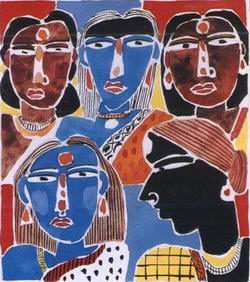 bThe possibility of members of SCGs standing for
and winning elections to local councils clearly depends on
solidarity within the group. The group is needed to gather the
strength to contest, to conduct the election campaign and to vote
and secure other votes in the election. Particularly for someone
from the poorer sections of society such an effort would be
impossible without a group. bThe possibility of members of SCGs standing for
and winning elections to local councils clearly depends on
solidarity within the group. The group is needed to gather the
strength to contest, to conduct the election campaign and to vote
and secure other votes in the election. Particularly for someone
from the poorer sections of society such an effort would be
impossible without a group.
But it is not only with respect
to such clearly group activities that the group is needed. Group
solidarity is needed to help women who are opposed in some
activities, or even in unrelated matters, by their husbands. Dealing
with domestic violence, and marital discord with the threat of
divorce (something on which men in Bangladesh very much have the
upper hand) are difficult at the individual level. Group
intervention is needed to protect women from eviction from their own
houses.
This the groups have done to quite an extent.
“Women’s solidarity in the samiti has increased a great deal. In one
case they took to task a husband who was rough with his wife, a
member of the samiti,” (Sreepur, Gazipur). “We have developed group
solidarity and identity as members of the samiti, which we have used
to prevent the taking of second wives by two men in this village. I
am also raising this (membership of the samiti) as a major point in
negotiating the marriage of my daughter,” Rashida, along with other
members of the SCG, (Tangail).
Back to
Content
8. The Market
The market has traditionally been the most taboo area for women.
This is so not only in purdah ridden Bangladesh, but also in most of
the Indo-Gangetic belt, including north India and Pakistan. Women
who go to the market lose social standing. If women do have to go to
the market, they should be as quick about it as possible.
Women may directly sell minor items, such as eggs and
vegetables, either at their doorsteps to itinerant traders or
through children taking them to market. Otherwise, they give the
produce to their husbands or other male members of the family who
take the produce to the market
Where there is a major change, however, is in going to the market
to buy something, like clothes for themselves and their children,
schoolbooks, cosmetics, jewellery, etc. Going to the market for such
purposes, either accompanied by their husbands or as a group of
women, has become a regular feature of women’s activities.
Back to
Content
9. Savings
 Women have three forms of savings – gold
jewellery, cash savings and in NGO account. The first is bought with
the full knowledge of their men. But there is a strong tendency to
hide any cash savings from their husbands and sons. This is not
something new in Bangladesh, where rural women have a long-standing
practice of ‘secret’ savings [Kabeer 2001: 75]. Women have three forms of savings – gold
jewellery, cash savings and in NGO account. The first is bought with
the full knowledge of their men. But there is a strong tendency to
hide any cash savings from their husbands and sons. This is not
something new in Bangladesh, where rural women have a long-standing
practice of ‘secret’ savings [Kabeer 2001: 75].
Traditionally jewellery was bought with ‘men’s money’,
ignoring women’s contribution to the household well-being. In the
event of divorce women were expected to leave everything they had,
except for the set of clothes they would wear, and that would be the
worst set they had. Any gold jewellery would remain behind with the
husband.
The other factor is that women might expect that since the
jewellery has been bought with their own money, they would be able
to claim the jewellery in the event of divorce.
Back to
Content
10. Village phone programme
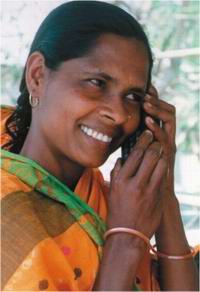 Professor Yunus has long argued that
information and communications technology (ICT) has the potential to
bring unprecendented employment opportunities for the poor. GB's
Village Phone Project is an extraordinary example of how powerful
ICT can be in the hands of the poor. A Grameen borrower receives a
handset with Grameen Bank financing and becomes the telephone-lady
of the village, selling telephone services to the villagers, usually
in places where fixed lines did not exist. In the process, she makes
an income on average higher than twice the national per capita
income. By October 2005, Grameen had provided more than 172,000 poor
women with mobile phones for income generation in villages across
Bangladesh. Professor Yunus has long argued that
information and communications technology (ICT) has the potential to
bring unprecendented employment opportunities for the poor. GB's
Village Phone Project is an extraordinary example of how powerful
ICT can be in the hands of the poor. A Grameen borrower receives a
handset with Grameen Bank financing and becomes the telephone-lady
of the village, selling telephone services to the villagers, usually
in places where fixed lines did not exist. In the process, she makes
an income on average higher than twice the national per capita
income. By October 2005, Grameen had provided more than 172,000 poor
women with mobile phones for income generation in villages across
Bangladesh.
Back to
Content
11. Pension fund and other savings
In recent years, Grameen Bank has introduced a range of
attractive new savings products for borrowers. The personal and
special savings accounts of old remain, but have been made more
flexible in terms of facilities available to them. GB has also
introduced pension deposit fund which enables the member to receive,
after a ten year period, a guaranteed amount which is almost double
the amount she has put in over that time. In October 2005, GB's
deposits total $441 million of which $282 million are its members
deposits. The savings products of Grameen Bank II are enabling not
only its members to become self reliant but has paved the way for
Grameen Bank's own self reliance.
Back to
Content
12. Self-reliance for GB
In 1995, GB decided not to receive any more donor funds, since
which time it has not requested any fresh funds from donors. The
last installment of donor fund which was in the pipeline was
received in 1998.
Today, Grameen Bank's total of outstanding
loans is approximately $405 million. Deposits as a percentage of
outstanding loans today is 109 percent. If it takes into account its
own resources as well as deposits, this percentage is 131 percent.
Since Grameen Bank came into being, it has made profit every year
except in 1983, 1991, and 1992. GB does not foresee having to take
any more donor money or even take new loans from internal or
external sources in future. GB's growing deposits will be more than
sufficient to repay its existing loans, and run and expand its
credit programme.
Back to
Content
13. High Cost of Microcredit
One of the complaints frequently made by women was that the cost
of credit from the NGOs was very high and should be brought down.
The other main complaint was that the loan given was very small,
with the concomitant demand that the loan limit should be
increased.
The now-standard rate of interest charged by NGOs
is 15 per cent. What makes it even higher is that while repayments
are collected weekly, meaning that 2 per cent of the principal is
returned every week, the interest rate is calculated over the whole
year on the full amount of the loan, and not on the outstanding
balance, as is the practice with commercial bank loans. This makes
the effective rate of interest over the whole year, amount to 30 per
cent. NGOs themselves admit that this is the possible actual rate of
interest [Ahammed 2003]. Where repayments are not fully collected
weekly the rate of return on NGO loans may fall to about 24 per
cent.
The NGOs justify this high rate of interest on the
basis of the high cost of supervision of microcredit [Ahammed 2003].
The cost of supervision of small loans with weekly repayments is
certainly higher than it is in the usual commercial bank
loans.
Often the members protest to pay high interest,:Micro-credit
and rural women and many cases it is misused but still
better than local money lenders.
Back to
Content
14. The Struggle for Survival and Credibility among the
Religious NGOs (Non-Governmental Organizations) in
Bangladesh
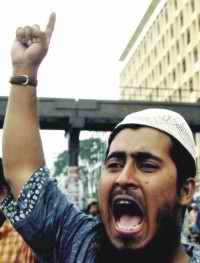 Many activist women understand Bangladesh as a
country that should encourage women's equality and promote harmony
between people of different faiths. Tragically, they face tremendous
opposition from religious figureheads along with the threats and
fatwas- was that fundamentalist insanity is gaining notoriety for.
Fatwas are proving quite effective in gaining results for ambitious
fundamentalist leaders world- wide, who deem explorative thought as
anathema to religious principles. Many activist women understand Bangladesh as a
country that should encourage women's equality and promote harmony
between people of different faiths. Tragically, they face tremendous
opposition from religious figureheads along with the threats and
fatwas- was that fundamentalist insanity is gaining notoriety for.
Fatwas are proving quite effective in gaining results for ambitious
fundamentalist leaders world- wide, who deem explorative thought as
anathema to religious principles.
For women, increasing fundamentalism in Bangladesh is a
threat to the little rights and freedoms that they currently have.
Women are already repressed by gender-biased social norms and
extreme poverty. Fundamentalist ideology could have detrimental
effects on women, and succeed in excluding and marginalizing them
even further. Eliza Griswold spoke with Mufti Fazlul Haque Amini,
who has served as a member of Parliament for the past three years.
She reported him saying that “he believes that secular law has
failed Bangladesh and that it’s time to implement Sharia, the legal
code of Islam”. This may not occur formally, but within the social
fabric of Bangladesh, and coupled with a legal system that
consistently fails to address issues of rape, torture and murder,
women are threatened both physically and emotionally, as well as
being crippled economically – due to increasing fundamentalist
forces within the country.
Biased mentalities that do not recognise women as equal citizens
could be compounded by localized Sharia interpretations of Islam,
where family laws “frequently require women to obtain a male
relative’s permission to undertake activities that should be theirs
by right. This increases the dependency women have on their male
family members in economic, social, and legal matters.
Since the independence of Bangladesh in 1971, the state has
largely failed to assist the poor or reduce poverty, and NGOs
have grown dramatically, ostens ibly to fill this gap. There are
more and bigger NGOs here than in any country of equivalent size.
The target group approach has allowed NGOs in Bangladesh to work
successfully with the rural poor and provide inputs to a
constituency generally bypassed by the state .
This
innovation led to a concentration of efforts into small-scale,
home-based income-generating activities such as cattle and
poultry-rearing, food processing, social forestry, apiculture and
rural handicrafts, combined with the provision of microcredit, to
which the landless had previously been denied access except from
local moneylenders at high cost. Recently, most NGOs in Bangladesh
have taken microcredit as their major activity, which has resulted
in resistance from some religious leaders and organisations.
Charging of interest is forbidden in Islam. NGOs said the
fundamentalists had objected to Muslim women going out to work.
Other NGO activities like non-formal schools for children and trees
planted by NGO clients have also been attacked. While religion and
development were considered to be two distinct categories with no
overlap for the better part of the 20th century, their
interdependence came to be recognized during the last decade. In
Bangladesh the link between religion and development is even more
evident, because religious and spiritual leaders have a great hold
on people’s hearts and actions. They can trigger impulses leading to
sustainable development or mar development through fundamentalist
attitudes. In Bangladesh, there is a general view that RNGOs are
well funded from outside. It is believed that Islamic NGOs are
funded by state agencies and NGOs of the oil-rich Gulf countries,
Christian missionary NGOs from their fellow Churches and their
followers.
An independent US panel on religious freedom expressed concern
Tuesday over growing Islamist militancy in Bangladesh and violence
against individuals and groups perceived as ‘un-Islamic.’ Bangladesh
could be a model for other emerging democracies with majority Muslim
populations but ‘that model is in jeopardy,’ warned Felice Gaer,
chairwoman of the US Commission on International Religious Freedom,
a bipartisan federal agency. She warned about ‘growing Islamist
militancy and the failure to prosecute those responsible for violent
acts carried out against Bangladeshi individuals, organisations and
businesses perceived as ‘un-Islamic.’,(New Age, October 19, 2006).
The
Shariah, Mullah and Muslims in Bangladesh
Back to
Content
15. CONCLUSION
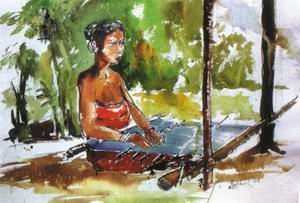 A study by World Bank economist Shahid Khandker in
2005 suggests that micro-finance contributes to poverty reduction,
especially for female participants, and to overall poverty reduction
at the village level in Bangladesh. Micro-finance thus helps not
only poor participants but also the local economy. Grameen Bank's
own internal survey based on 10 objective indicators shows that 55
percent of its members have already crossed the poverty line. A study by World Bank economist Shahid Khandker in
2005 suggests that micro-finance contributes to poverty reduction,
especially for female participants, and to overall poverty reduction
at the village level in Bangladesh. Micro-finance thus helps not
only poor participants but also the local economy. Grameen Bank's
own internal survey based on 10 objective indicators shows that 55
percent of its members have already crossed the poverty line.
A Social Change needs also Political Change
Yunus told the press (October 17, 2006) that he would ‘continue
his campaign for promoting clean and competent candidates in
national polls’, adding: ‘If necessary, I’ll form a political
party.’ He said there has been a suggestion that the campaign for
clean candidates will not be successful if its protagonists are not
part of the political process. ‘Is it too hard to form a party?’ he
asked the people present. The country is trapped in a political maze
and people are looking for a way out, observed Yunus. ‘We need to
break out of this maze. I am not saying that I will be successful.
But the effort should be made,’ he added. However, the Awami
League’s general secretary, Abdul Jalil, declined to say anything
about Yunus’ plan to float a political party, ‘if necessary’.
Nobel laureate Professor Muhammad Yunus’s wish to form a
political party evoked mixed reactions among political and civil
society circles. While some politicians refused to comment, others
reminded him of the difficulties involved in political activism. The
civil society leaders were also divided on the issue, with some of
them hailing the idea and others advising him to remain above
politics.
After two decades and more of NGO micro-credit based activity,
there is no longer an idea that women’s income-earning activities
are temporary and reversible. These new practices also have their
counterpart in new norms of status of women and thus the creation of
a new culture. As discussed below, there is a clear change in gender
norms and the creation of new norms of the non-exclusionary type.
Women have begun to think of new norms. On the whole, they
do not justify their practices in terms of the old norms of purdah,
or even as temporary deviations from the same. In discussions with
the women of the SCGs, it was repeatedly pointed out that samman or
respect no longer consisted of being in purdah. This repeated
assertion tells us that new norms are being created, more in
consonance with the new practices.
Who is a sammani mahila, a
woman of honour or respect? “A woman, who has land, education and
knowledge. Health is also important. We do not agree with the
traditional idea of purdah-nashin (women in purdah) as being
respected.” One woman of this group in fact said, “Purdah is like a
prison; one who stays at home, and whose resources are under the
control of husband or son is like a prisoner,” (Narsinghdi).
“One who is working outside the home has her own
money/independent earnings and is free to go anywhere. She must be
educated and also well behaved, she must not shout at or ignore the
poor and illiterate,” women said in chorus during field discussions
(Raipura, Narsinghdi).
The field of the changes were initially and still are primarily
economic, the development of various types of micro-enterprises,
etc. But the new types of practice in their humblest forms change
the very structure of the social conditions of production that “lead
the dominated to take the point of view of the dominant on the
dominant and on themselves” [Bourdieu 2001: 42]. What is the change
in the social condition of production? In the briefest manner this
can be expressed as a change in the social structure of accumulation
at the level of the household from having been a men-centred
accumulation, an accumulation in men’s hands, to an accumulation
that is also partly women-centred, some accumulation in women’s
hands.
But what gives us a clue to the far-reaching consequences of this
transformation is the manner in which gender norms of respect are
being re-created from glorifying purdah-nashin women or their
seclusion and dependence to valuing independent income, education,
work outside the home, mobility and professional engagement. As
women changed their practice, over time so too have they changed the
norms and the concepts with which they make sense of the world.
“Gradually and steadily, we will break all these shackles of
tradition that bind us as women,” says Nargis (a pregnant woman and
mother of three children) with the support of most members of an
UPAMA SCG. Savita, a member of another SCG in Kishoreganj, says, “If
I could provide education to my daughter, she would then become as
important as the son in the family”
Back to
Content
16. References
Yunus, M., August 2006,
Bhatti, K. 2005. “Political chaos, Islamic fundamentalism and
poverty”. Available from
http://www.socialistworld.net/eng/2005/02/10bangladesh.html
Asia News 2005. “People defend democracy against rise in Islamic
extremism”. 11 February 2005.
Kabeer, Naila (2000): The Power to Choose: Bangladeshi Women
Workers and Labour Market Decisions, Vistaar Publications, New
Delhi. – (2001): ‘Conflicts Over Credit: Re-Evaluating the
Empowerment Potential of Loans to Women in Rural Bangladesh’ in
World Development, Vol 29, No 1, pp 63-84.
Govind Kelkar, Dev Nathan, Rownok Jahan, Microcredit and Gender
Relations in Rural Bangladesh, EPW, 2004.
Morshed, L. , Feb 4, 2006, Rochelle Jones 27 May, 2005.
Asia News 2005. People defend democracy against rise in Islamic
extremism.
11 February 2005, The Daily Star.
Bengali Newspapers, Daily Ittefaque, Jugantor, Prothom Alo.
Ahammed, Iqbal (2003): ‘Rate of Interest in Micro-Credit Sector:
Comparing NGOs with Commercial Banks’, paper presented at
International Seminar on Attacking Poverty with Micro-Credit, PKSF,
Dhaka, January 8-9,
Rozario, Santi (2002): ‘Gender Dimensions of Rural Change’ in
Kazi Ali Toufique and Cate Turton (eds), Hands Not Land: How
Livelihoods are Changing in Rural Bangladesh, BIDS and DFID,
Dhaka
.
UNFPA (2003): ‘Assessment of Male Attitudes Towards Violence
against Women’, reported in The Bangladesh Observer, Dhaka, August
14.,2005)
Top of
Page
Last Modified:July 24, 2007 |
| |


 The success of Grameen project
is entirely due to the responsiblity and participatation by
the women. Rabinranath Tagore knew this.
The success of Grameen project
is entirely due to the responsiblity and participatation by
the women. Rabinranath Tagore knew this.

 In Bangladesh, the unintended
consequences of the microcredit system with NGOs as partners have
been far-reaching. The very structure of social production that
focused on 'man as the breadwinner' has changed to accommodate a
substantial and permanent role for women as income-earners.
In Bangladesh, the unintended
consequences of the microcredit system with NGOs as partners have
been far-reaching. The very structure of social production that
focused on 'man as the breadwinner' has changed to accommodate a
substantial and permanent role for women as income-earners. Grameen Bank was initiated in 1976 by
Professor Muhammad Yunus as an action research project of Chittagong
University. In a village near the university called Jobra, he found
that the poor did not have access to small amounts of capital to
engage or build on their tiny livelihood activities. The only source
of capital were loans from money- lenders at exorbitant rates of
interest. As an experiment, he began a project to provide small
loans to poor women in Jobra to engage in income generating
activities. In all cases, the poor women took loans from the
project, invested their money, and generated enough income to pay
back their loans and keep a profit.
Grameen Bank was initiated in 1976 by
Professor Muhammad Yunus as an action research project of Chittagong
University. In a village near the university called Jobra, he found
that the poor did not have access to small amounts of capital to
engage or build on their tiny livelihood activities. The only source
of capital were loans from money- lenders at exorbitant rates of
interest. As an experiment, he began a project to provide small
loans to poor women in Jobra to engage in income generating
activities. In all cases, the poor women took loans from the
project, invested their money, and generated enough income to pay
back their loans and keep a profit. The Grameen Bank operates on the premise that
the poor remain poor, not because they do not work or do not have
skills, but because the institutions created around them keep them
poor. Charity is not a solution to poverty, but rather fosters
dependency, thus perpetuating poverty. All human beings are born
with unlimited potential, and merely require an opportunity to
unleash that potential. Professor Yunus argues that credit provides
that opportunity and should therefore be considered a human
right.
The Grameen Bank operates on the premise that
the poor remain poor, not because they do not work or do not have
skills, but because the institutions created around them keep them
poor. Charity is not a solution to poverty, but rather fosters
dependency, thus perpetuating poverty. All human beings are born
with unlimited potential, and merely require an opportunity to
unleash that potential. Professor Yunus argues that credit provides
that opportunity and should therefore be considered a human
right. After independence in 1971 and
restoring democracy in ’91, Bangladesh witnessed the biggest
achievement as Professor Muhammad Yunus and his Grameen Bank
were declared yesterday to win the Nobel Peace Prize 2006 for
pioneering the use of micro-credit to benefit poor
entrepreneurs. Prof Yunus is the first Bangladeshi and also
the third Bangalee after poet Rabindranath Tagore and
economist Amartya Sen to win the Nobel Prize. Grameen Bank,
founded by Prof Yunus, has been instrumental by offering loans
to millions of poor Bangladeshis, many of them women, without
any financial security, in improving their standard of living
by starting businesses with the tiny borrowed sums
After independence in 1971 and
restoring democracy in ’91, Bangladesh witnessed the biggest
achievement as Professor Muhammad Yunus and his Grameen Bank
were declared yesterday to win the Nobel Peace Prize 2006 for
pioneering the use of micro-credit to benefit poor
entrepreneurs. Prof Yunus is the first Bangladeshi and also
the third Bangalee after poet Rabindranath Tagore and
economist Amartya Sen to win the Nobel Prize. Grameen Bank,
founded by Prof Yunus, has been instrumental by offering loans
to millions of poor Bangladeshis, many of them women, without
any financial security, in improving their standard of living
by starting businesses with the tiny borrowed sums
 Yunus, dubbed "Banker to the
Poor", began fighting poverty during a 1974 famine in
Bangladesh with a loan of $27 out of his pocket to help 42
women buy weaving tools to save them from the clutches of the
moneylenders. "They got the weaving tools quickly, they
started to weave quickly and they repaid him quickly," said
Mjøs. "Yunus and Grameen Bank have shown that even the poorest
of the poor can work to bring about their own development,"
the Nobel Committee said in its citation.
Yunus, dubbed "Banker to the
Poor", began fighting poverty during a 1974 famine in
Bangladesh with a loan of $27 out of his pocket to help 42
women buy weaving tools to save them from the clutches of the
moneylenders. "They got the weaving tools quickly, they
started to weave quickly and they repaid him quickly," said
Mjøs. "Yunus and Grameen Bank have shown that even the poorest
of the poor can work to bring about their own development,"
the Nobel Committee said in its citation.  Bangladesh, experts and others say, is less poor than we
think. Yet few are convinced, and nobody tells us who can make us
smile. Once the state could control prices to some degree, but in
this laissez-faire world of non-accountability the free market
becomes an excuse for not keeping misery under control. If nobody
can keep the prices down, of what use is the state, anyway. Might as
well hand the state over to the "syndicate" or an NGO or whoever,
some might say.
Bangladesh, experts and others say, is less poor than we
think. Yet few are convinced, and nobody tells us who can make us
smile. Once the state could control prices to some degree, but in
this laissez-faire world of non-accountability the free market
becomes an excuse for not keeping misery under control. If nobody
can keep the prices down, of what use is the state, anyway. Might as
well hand the state over to the "syndicate" or an NGO or whoever,
some might say.  Conventional banks, however, do not
lend to the poor. Banks require collateral and have complicated
procedures that the poor cannot satisfy. The poor are therefore
exploited by money-lenders and traders who operate a system of usury
in villages which is equivalent to bonded labour and slavery. In
another difference with normal banks, ‘Grameen Bank branches are
located in rural areas, whereas the branches of conventional banks
usually locate themselves as close as possible to the business
districts and urban centres. In perhaps the biggest difference, the
first principle of Grameen banking is that clients should not go to
the bank, it is the bank that should go to the people.
Conventional banks, however, do not
lend to the poor. Banks require collateral and have complicated
procedures that the poor cannot satisfy. The poor are therefore
exploited by money-lenders and traders who operate a system of usury
in villages which is equivalent to bonded labour and slavery. In
another difference with normal banks, ‘Grameen Bank branches are
located in rural areas, whereas the branches of conventional banks
usually locate themselves as close as possible to the business
districts and urban centres. In perhaps the biggest difference, the
first principle of Grameen banking is that clients should not go to
the bank, it is the bank that should go to the people.

 Today, all the children of Grameen
Bank members are in school. Studies show that Grameen Bank members
have lower birth rate than non-members. Their housing is better and
the use of sanitary latrines is higher than non-members. Their
participation in social and political activities is higher than that
of non-members, and reflects how seriously the members implement
these decisions.
Today, all the children of Grameen
Bank members are in school. Studies show that Grameen Bank members
have lower birth rate than non-members. Their housing is better and
the use of sanitary latrines is higher than non-members. Their
participation in social and political activities is higher than that
of non-members, and reflects how seriously the members implement
these decisions.
 What stands out from Tables 1 is the
predominance of agriculture and related activities in the areas of
livelihood investment – crops, poultry, livestock and vegetables.
Non-agriculture based activities, which include small business, like
tailoring shops, and the clearly men-operated sectors of transport,
firewood and powerloom, all together account for just 15 per cent of
loan uses; adding the 14 per cent in small business, that gives a
total of 29 per cent loans used by men. The possibly more accurate
projectwide figures on main use of loans account for 35 per cent of
loan uses in men’s activities, if we take all non-agriculture
related activities as being men’s activities.
What stands out from Tables 1 is the
predominance of agriculture and related activities in the areas of
livelihood investment – crops, poultry, livestock and vegetables.
Non-agriculture based activities, which include small business, like
tailoring shops, and the clearly men-operated sectors of transport,
firewood and powerloom, all together account for just 15 per cent of
loan uses; adding the 14 per cent in small business, that gives a
total of 29 per cent loans used by men. The possibly more accurate
projectwide figures on main use of loans account for 35 per cent of
loan uses in men’s activities, if we take all non-agriculture
related activities as being men’s activities.
 An increase in consumption is to be
expected with an increase in income. Along with a quantity increase
there is also a quality increase in food consumption. Almost
invariably women said that while they earlier had a little vegetable
and not much more with each meal, now they consume more vegetables,
and also eggs and fish once a week each, dal twice a week, and
chicken or beef, once a month, (Bhuapur and Raipura, Narsinghdi). In
another SCG, it was said that they earlier ate fish or meat just
once a month, but now they could afford these once a week. Another
group said that while earlier they ate fish or meat only two or
three times in a month, now their children have milk and eggs almost
daily, (Delduar, Tangail).
An increase in consumption is to be
expected with an increase in income. Along with a quantity increase
there is also a quality increase in food consumption. Almost
invariably women said that while they earlier had a little vegetable
and not much more with each meal, now they consume more vegetables,
and also eggs and fish once a week each, dal twice a week, and
chicken or beef, once a month, (Bhuapur and Raipura, Narsinghdi). In
another SCG, it was said that they earlier ate fish or meat just
once a month, but now they could afford these once a week. Another
group said that while earlier they ate fish or meat only two or
three times in a month, now their children have milk and eggs almost
daily, (Delduar, Tangail). From the fact that a part of household
income now accrues to or through women, one would expect a greater
participation of women in household decision-making. Women generally
report such greater participation. There was more consultation with
women, rather than the earlier unilateral decision-making by men. In
cases where women used credit money to run their own
micro-enterprises, they said that they had more of a say than in
cases where they gave the money to their husbands or sons.
From the fact that a part of household
income now accrues to or through women, one would expect a greater
participation of women in household decision-making. Women generally
report such greater participation. There was more consultation with
women, rather than the earlier unilateral decision-making by men. In
cases where women used credit money to run their own
micro-enterprises, they said that they had more of a say than in
cases where they gave the money to their husbands or sons.
 Many of the points made above show that there is an
increased self-esteem and enhanced dignity, both within the
household and within society, for these women. The women point out
that their men consult them much more than earlier. Instead of just
buying any clothes for their wives, now they would ask for their
preferences before going to the market. Of course, in a number of
cases women themselves were going to the market to buy their own
clothes.
Many of the points made above show that there is an
increased self-esteem and enhanced dignity, both within the
household and within society, for these women. The women point out
that their men consult them much more than earlier. Instead of just
buying any clothes for their wives, now they would ask for their
preferences before going to the market. Of course, in a number of
cases women themselves were going to the market to buy their own
clothes.  bThe possibility of members of SCGs standing for
and winning elections to local councils clearly depends on
solidarity within the group. The group is needed to gather the
strength to contest, to conduct the election campaign and to vote
and secure other votes in the election. Particularly for someone
from the poorer sections of society such an effort would be
impossible without a group.
bThe possibility of members of SCGs standing for
and winning elections to local councils clearly depends on
solidarity within the group. The group is needed to gather the
strength to contest, to conduct the election campaign and to vote
and secure other votes in the election. Particularly for someone
from the poorer sections of society such an effort would be
impossible without a group.  Women have three forms of savings – gold
jewellery, cash savings and in NGO account. The first is bought with
the full knowledge of their men. But there is a strong tendency to
hide any cash savings from their husbands and sons. This is not
something new in Bangladesh, where rural women have a long-standing
practice of ‘secret’ savings [Kabeer 2001: 75].
Women have three forms of savings – gold
jewellery, cash savings and in NGO account. The first is bought with
the full knowledge of their men. But there is a strong tendency to
hide any cash savings from their husbands and sons. This is not
something new in Bangladesh, where rural women have a long-standing
practice of ‘secret’ savings [Kabeer 2001: 75].
 Professor Yunus has long argued that
information and communications technology (ICT) has the potential to
bring unprecendented employment opportunities for the poor. GB's
Village Phone Project is an extraordinary example of how powerful
ICT can be in the hands of the poor. A Grameen borrower receives a
handset with Grameen Bank financing and becomes the telephone-lady
of the village, selling telephone services to the villagers, usually
in places where fixed lines did not exist. In the process, she makes
an income on average higher than twice the national per capita
income. By October 2005, Grameen had provided more than 172,000 poor
women with mobile phones for income generation in villages across
Bangladesh.
Professor Yunus has long argued that
information and communications technology (ICT) has the potential to
bring unprecendented employment opportunities for the poor. GB's
Village Phone Project is an extraordinary example of how powerful
ICT can be in the hands of the poor. A Grameen borrower receives a
handset with Grameen Bank financing and becomes the telephone-lady
of the village, selling telephone services to the villagers, usually
in places where fixed lines did not exist. In the process, she makes
an income on average higher than twice the national per capita
income. By October 2005, Grameen had provided more than 172,000 poor
women with mobile phones for income generation in villages across
Bangladesh.
 Many activist women understand Bangladesh as a
country that should encourage women's equality and promote harmony
between people of different faiths. Tragically, they face tremendous
opposition from religious figureheads along with the threats and
fatwas- was that fundamentalist insanity is gaining notoriety for.
Fatwas are proving quite effective in gaining results for ambitious
fundamentalist leaders world- wide, who deem explorative thought as
anathema to religious principles.
Many activist women understand Bangladesh as a
country that should encourage women's equality and promote harmony
between people of different faiths. Tragically, they face tremendous
opposition from religious figureheads along with the threats and
fatwas- was that fundamentalist insanity is gaining notoriety for.
Fatwas are proving quite effective in gaining results for ambitious
fundamentalist leaders world- wide, who deem explorative thought as
anathema to religious principles.  A study by World Bank economist Shahid Khandker in
2005 suggests that micro-finance contributes to poverty reduction,
especially for female participants, and to overall poverty reduction
at the village level in Bangladesh. Micro-finance thus helps not
only poor participants but also the local economy. Grameen Bank's
own internal survey based on 10 objective indicators shows that 55
percent of its members have already crossed the poverty line.
A study by World Bank economist Shahid Khandker in
2005 suggests that micro-finance contributes to poverty reduction,
especially for female participants, and to overall poverty reduction
at the village level in Bangladesh. Micro-finance thus helps not
only poor participants but also the local economy. Grameen Bank's
own internal survey based on 10 objective indicators shows that 55
percent of its members have already crossed the poverty line.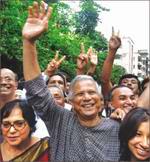 1. Vision for Bangladesh
1. Vision for Bangladesh